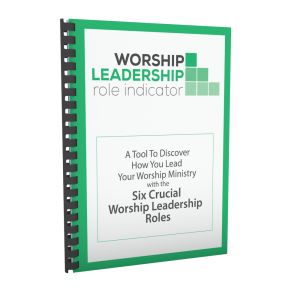Senior Pastor: How To Lead Your Disorganized Worship Pastor
As I’ve worked with worship leaders over the years, I’ve recognized six crucial leadership roles every worship ministry needs. These six roles will encompass the expectations you and your church have for your worship leader.
Unfortunately, your worship leader is terrible at two of these roles.
But so is every other worship leader!
The leadership roles necessary to lead a healthy and successful worship ministry require a gamut of gifts no ONE leader could ever possess. I’ll tell you what these roles are in a moment. But first, here’s how they break down for most people:
Most worship leaders are absolute rockstars in one or two of the six roles. These roles are life-giving. It’s where your worship leader quickly finds the flow state in his work.
Most worship leaders are OK at two to three of the six roles. They get the job done, but it’s not in their wheelhouse. This work can range from, “I kind of like it” to “it’s just part of the job.”
And one to two of the six roles are outside their strength and gift mix. These roles are soul-sucking.
A good worship leader understands their strong roles and builds a team around them to complement the weak areas. One of the best gifts you can give your worship ministry leader is to help them lean into their strengths and build a leadership team to complement their weak areas.
So, as you read through each of these six crucial worship leadership roles, you’ll likely identify the top two and the bottom two for your worship leader.
The Six Crucial Worship Leadership Roles:
- Congregational Leader:
This is the on-platform person leading the songs, engaging the congregation, and modeling worship—the lead “lead worshiper.”
(Note: He or she is often thought of as “the worship leader.” However, that title is commonly used for the leader of the entire worship ministry. So for the sake of clarity, we use “congregational leader” to describe this role.)
Often, musically talented and creative worship leaders are confident in this upfront role. But it can become about their own artistic expression or personal worship time.
A true ‘congregational worship leader’ has a dual role: he loves and serves the congregation AND worships God.
- Musical Director:
This is the person who leads the band and sometimes the vocal team.
They know…
- the flow of the set,
- the segues,
- the dynamic journey of the songs…
…and they have the musical and production skills to direct the band to make it happen.
Their main goal is to make it easy for the congregational leader to engage the congregation and lead worship.
Many creatives flourish in this area. Unfortunately, the performance of the band and quality of production becomes the primary focus.
And many worship leaders who are strong in this role let the musical leadership distract them from leading the congregation.
- Service Planner (or Worship Designer):
This is the person who plans the service or setlists. A person gifted in this role skillfully creates an intentional journey and a dynamic flow to the service.
The Worship Designer is another role many creatives absolutely rock. But often, they overemphasize the production and flow of the set and neglect the worship journey for the congregation.
- Team Shepherd:
This is the leader who cares for and nurtures the team members.
Some creatives are highly relational, have strong empathy, a gift of mercy, and other strengths that make them fantastic shepherds.
Some creatives would rather gnaw their leg out of a bear trap than focus on the relational side of ministry. Their personality and gift mix make it challenging to do the relational work of ministry. For these creative worship leaders, they can fall into the trap of loving the production of Sunday more than the people.
Be honest with your worship leader if you see this. It will hurt. But your church deserves a worship leader who loves people, not just one who produces Sunday.
You should consider outside leadership coaching if your worship leader struggles with this. I have a gifted leadership coach on my team who can help drill down to some of the root issues, and then make an actionable plan to grow in this area.
Let’s talk and see if that would be a good fit for your worship leader. [Go here to schedule a free consultation]
- Administrative Leader:
This is the leader who can create and implement the systems and processes that make the worship ministry run effectively. He or she may or may not be gifted to manage the details of those systems.
Process thinking doesn’t lie exclusively with creative or non-creative people. But when a creative worship leader can “see” the system and process solutions to their ministry problems, you’ve just discovered gold. The creative part of their brain applies solutions most of us would never see coming.
But when the creative worship leader struggles with seeing and implementing processes, they need coaching and direction. Intentional systems will free the creative worship leader to do their best work.
- Visionary Leader:
This is the leader who helps the team move into the future. They are future-oriented, leading the charge toward improvement and new initiatives.They hate the status quo. For them, change is like Moose Tracks ice cream- it’s tasty.
Some creative worship leaders are future-oriented. Some aren’t. Either way, you’ll probably need to intervene.
What Are Your Worship Leader’s Best (and Worst) Roles?
So there are the six crucial worship leader roles:
- Congregational Leader
- Musical Director
- Worship Designer
- Team Shepherd
- Administrative Leader
- Visionary Leader
I can’t tell you which two roles your team member struggles with. However, if you’ve read this far, I can safely assume he or she isn’t strong at administrative leadership.
I’m also guessing you can rank all six roles in order from strongest to weakest for your worship leader. But I’d like to give you a tool that will help you create a healthy conversation about these different roles with your worship leader.
 It’s our Worship Leadership Role Indicator. It’s a simple, self-scoring assessment that quantifies your worship leader’s strength for each of these roles.
It’s our Worship Leadership Role Indicator. It’s a simple, self-scoring assessment that quantifies your worship leader’s strength for each of these roles.
Now, since it is self-scoring, it will give insight into how your worship leader perceives their own leadership. If they are younger, or just not very self-aware, this indicator tool will open up a chance for you to talk frankly about their blindspots and challenge areas.
Also, the tool is most effective when others complete as if they were the worship leader. It helps the leader see how others perceive his/her leadership.
We’ve included this Worship Leadership Role Indicator in the free Lead Your Disorganized Worship Pastor Resource Bundle. You can get free access to this bundle here.
This article was originally published in Worship Musician Magazine, April 2024 issue and has been modified from the original.
Stuck?
Learn how to level-up your team with this free video training.







